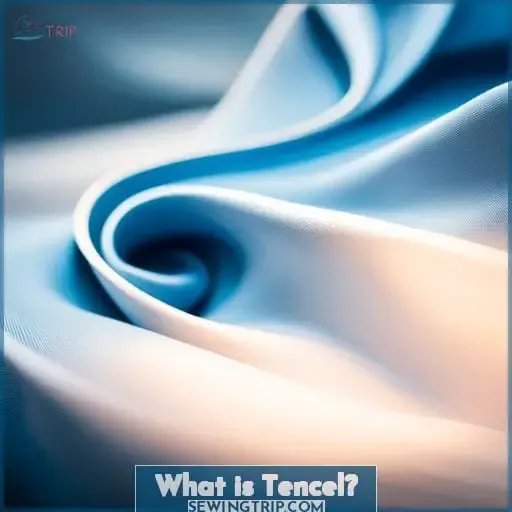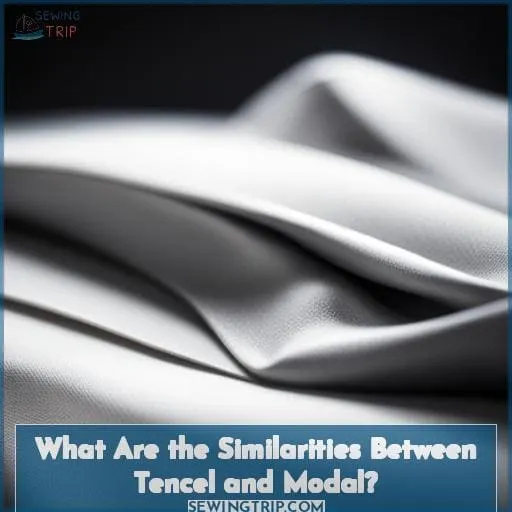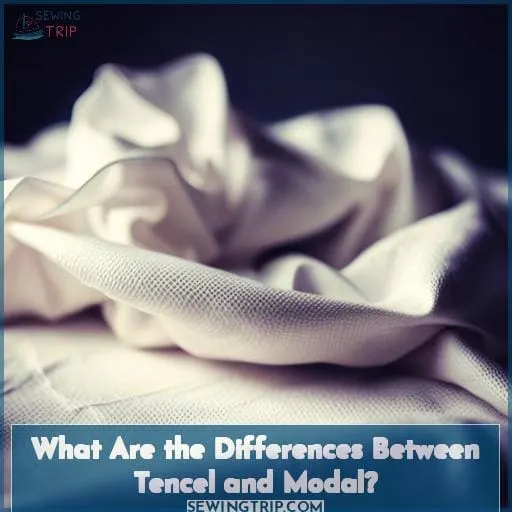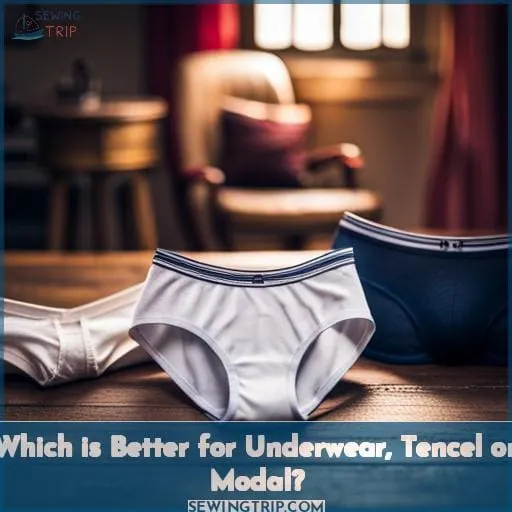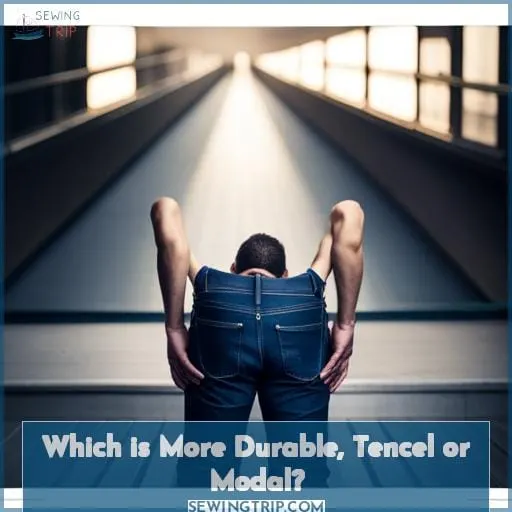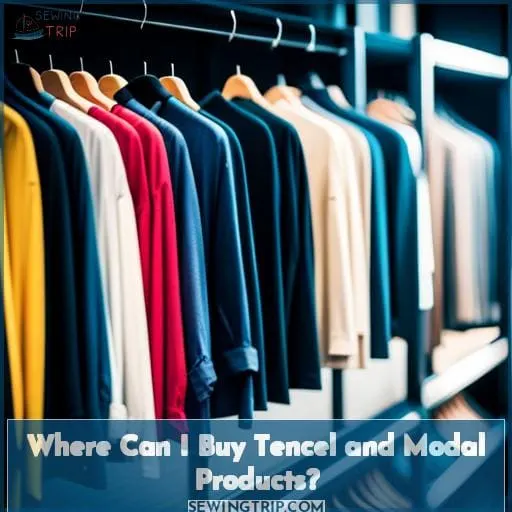This site is supported by our readers. We may earn a commission, at no cost to you, if you purchase through links.
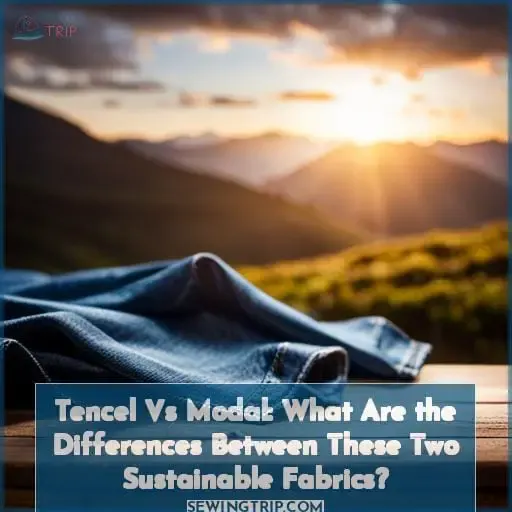 Tencel and modal are two sustainable fabrics that are often compared to each other.
Tencel and modal are two sustainable fabrics that are often compared to each other.
In this article, we will explore the similarities and differences between tencel and modal to help you decide which fabric is right for you.
- Both tencel and modal are made from wood pulp.
- Both fabrics are biodegradable and compostable.
- Both fabrics are soft and luxurious to the touch.
- Both fabrics are moisture-wicking and breathable.
- Both fabrics are wrinkle-resistant.
- Tencel is made from lyocell, while modal is made from viscose.
- Tencel is more durable than modal.
- Tencel is more expensive than modal.
Ultimately, the best fabric for you depends on your individual needs and preferences. If you are looking for a sustainable, soft, and luxurious fabric that is both durable and wrinkle-resistant, then tencel is a good option for you.
If you are looking for a more affordable option, then modal is a good option for you.
Table Of Contents
- Key Takeaways
- What is Tencel?
- What is Modal?
- What Are the Similarities Between Tencel and Modal?
- What Are the Differences Between Tencel and Modal?
- Which is Better for Sleepwear, Tencel or Modal?
- Which is Better for Underwear, Tencel or Modal?
- Which is More Durable, Tencel or Modal?
- Which is More Expensive, Tencel or Modal?
- Where Can I Buy Tencel and Modal Products?
- How Do I Care for Tencel and Modal Products?
- Frequently Asked Questions (FAQs)
- Conclusion
Key Takeaways
- Tencel is made from lyocell, while modal is made from viscose.
- Tencel is more durable than modal.
- Tencel is more expensive than modal.
- Modal is more absorbent than Tencel.
What is Tencel?
Tencel is a sustainable fabric made from wood pulp, known for its softness and moisture-wicking properties.
Tencel is made from eucalyptus trees, specifically the cellulose extracted from their wood pulp. This extraction process involves dissolving the wood in a closed-loop system without the use of harsh chemicals or intensive processes.
One of the key advantages of Tencel as a fabric is its sustainability. The production process used to create Tencel has minimal impact on the environment compared to other fabrics like rayon or polyester.
Additionally, Tencel fibers are biodegradable and can break down naturally over time.
Furthermore, Tencel offers exceptional breathability and moisture-wicking properties due to its cellulosic nature. These qualities make it ideal for clothing items such as activewear or bedding where comfort and temperature regulation are important factors.
In summary, TENCEL™ Lyocell stands out among other similar cellulosic fibres because they exhibit higher strength characteristics along with excellent dry fibre properties. TENCEL™ Lyocell fibres also contribute towards greater environmental responsibility thanks to their low emission levels while providing unique physical property performance benefits.
Its versatility allows it not only be blended with cotton , wool ,polyester,Linen but also be spun alone into yarns varying in weight.
What is Modal?
Modal is a type of sustainable fabric that shares many similarities with Tencel, but also has its own unique properties.
Here are some key points about Modal:
- Modal is made from beech wood, which makes it an eco-friendly choice.
- It’s stronger than rayon and more durable than Tencel.
- Modal is more absorbent than Tencel, making it ideal for clothing items like underwear and activewear.
- However, due to its superior qualities, modal tends to be more expensive compared to Tencel.
Overall, if you’re looking for a sustainable fabric that offers durability and excellent moisture-wicking capabilities, modal may be the right choice for you. Its softness and strength make it suitable for various applications in the fashion industry.
Keep in mind that while modal might come at a higher price point compared to other fabrics like Tencel or rayon because of its exceptional quality.
What Are the Similarities Between Tencel and Modal?
When considering sustainable fabrics, it’s important to note the similarities between Tencel and Modal.
Both Tencel and Modal are made from natural materials, making them eco-friendly choices.
Additionally, both fabrics are biodegradable, meaning they can break down naturally without causing harm to the environment.
Another similarity is that both Tencel and Modal have moisture-wicking properties. This means that they can effectively absorb moisture away from the body, keeping you dry and comfortable throughout the day or night.
Because of these properties, both Tencel and Modal are perfect for sleepwear and underwear as they help regulate body temperature and keep you feeling fresh.
These similarities make modal fabric a popular choice in creating tencel modal clothing with desirable lyocell properties.
What Are the Differences Between Tencel and Modal?
Both Tencel and Modal have their similarities, but now let’s delve into the differences between these two sustainable fabrics. You may be wondering how they differ in terms of their properties and characteristics.
- Modal is stronger than Tencel:
One key difference between Modal and Tencel is that modal fabric tends to be stronger than Tencel.
- Modal is more absorbent than Tencel:
Another difference lies in the absorbency of the fabrics. Modal has a higher level of moisture absorption compared to Tencel, making it great for sleepwear as it can help keep you dry throughout the night.
- Modal is more expensive than Tencel:
Which is Better for Sleepwear, Tencel or Modal?
When it comes to sleepwear, both Tencel and Modal have their own unique qualities that make them suitable options.
In terms of absorbency, Modal has a slight edge over Tencel. Its fibers can quickly wick away moisture from the skin, keeping you cool and dry throughout the night. Additionally, Modal offers exceptional drape and stretchability, allowing for comfortable movement as you sleep.
On the other hand, while Tencel may not be as absorbent as Modal when it comes to sleepwear applications specifically; its natural moisture-wicking properties still provide a breathable and comfortable sleeping experience.
Moreover,Tencel’s smooth surface lends itself well to preventing pilling or fuzziness on your sleepwear garments over time.
In terms of luster or shine factor in fabrics used for sleepwear , both fabrics are similar.TENCEL™ Lyocell bed sheet sets are exceptionally breathable making them perfect for temperature-regulating bedding ensuring deep blissful sleeps.
Ultimately,the choice between Tencel and Modal will depend on personal preferences such as desired level of absorbency,drape,stretch,pilling resistance,and aesthetic factors like sheen.When choosing sustainable fabric options,sleepers can rest easy knowing that both materials contribute positively towards sustainability efforts in fashion industry.
Which is Better for Underwear, Tencel or Modal?
For underwear, Tencel is the better choice compared to Modal due to its enhanced softness and moisture-wicking properties.
Tencel, also known as lyocell, offers a luxurious feel against the skin and helps keep you dry by absorbing moisture away from your body.
On the other hand, while Modal is still a comfortable option for underwear with its smooth texture, Tencel provides an even softer touch that many find preferable for intimate wear.
Additionally, Tencel’s natural ability to wick away sweat makes it ideal for keeping you cool and comfortable throughout the day.
While both fabrics are environmentally friendly choices due to their sustainable production methods using renewable resources like bamboo or beechwood trees respectively (in case of modal), when it comes specifically to underwear comfort and performance,
TENCEL™ Lyocell proves superior over modal in terms of softness and moisture management.
Which is More Durable, Tencel or Modal?
If you’re looking for a sustainable fabric that’s durable and long-lasting, Tencel may be the better choice compared to Modal.
- Modal Pilling: While both fabrics are known for their softness and smooth feel, modal has a higher tendency to pill over time. Pilling occurs when short fibers on the surface of the fabric tangle together, leading to small balls or pills forming.
- Modal Shrinkage: Another factor affecting durability is shrinkage after washing. Modal has a higher likelihood of shrinking compared to Tencel, which can affect the fit and overall longevity of garments made from this fabric.
- Modal Colorfastness: Colorfastness refers to how well a fabric retains its color after repeated washings or exposure to sunlight. Tencel tends to have better colorfastness than modal, meaning it will retain its vibrant colors for longer.
Overall, if you prioritize durability in your clothing choices, opting for Tencel over modal would be wise due to its lower propensity for pilling and shrinkage as well as superior color retention properties.
Which is More Expensive, Tencel or Modal?
Tencel and Modal, both being sustainable fabrics, have their own distinct qualities that set them apart.
When it comes to price, Tencel lyocell tends to be more expensive than Modal. This is primarily due to the production process and sourcing of the raw materials used in each fabric.
Tencel is made from wood pulp derived from sustainably harvested eucalyptus trees, while Modal is made from beech wood.
The manufacturing process for Tencel involves a closed-loop system that uses less water and chemicals compared to other methods of producing rayon or viscose fabrics.
On the other hand, modal production requires fewer processing steps which can help keep costs lower overall. However, it’s important to note that pricing may vary depending on brand and quality considerations within each fabric category.
Where Can I Buy Tencel and Modal Products?
You can purchase Tencel and Modal products at various retailers both online and in-store.
- Online Retailers:
- Websites like Amazon, eBay, and Zappos offer a wide range of Tencel and Modal products, including clothing, bedding, and footwear.
- Department Stores:
- Major department stores such as Macy’s, Nordstrom, and Bloomingdale’s carry brands that use Tencel or Modal in their collections.
- Boutiques:
- Specialty boutiques often focus on sustainable fashion choices. Look for local boutiques or search online for eco-friendly shops that sell Tencel or Modal items.
- Sustainable Brands:
- Many ethical fashion brands prioritize using environmentally friendly materials like Tencel or Modal. Explore websites of sustainable clothing companies to find pieces made from these fabrics.
- Athleisure Stores:
- If you’re looking specifically for activewear made with Tencel or Modal blends that provide comfort during workouts while being gentle on the environment.
Whether you prefer shopping from the comfort of your home through online retailers like Amazon or exploring local department stores,boutique,and athleisure store options,TENCEL™ Lyocell is more durable than modal
- If you’re looking specifically for activewear made with Tencel or Modal blends that provide comfort during workouts while being gentle on the environment.
How Do I Care for Tencel and Modal Products?
To keep your Tencel and modal products in good condition, machine wash them in cold water on a gentle cycle.
- Machine wash in cold water on a gentle cycle.
- Tumble dry on low heat.
- Line dry or steam iron if needed.
Frequently Asked Questions (FAQs)
What are the environmental impacts of Tencel and Modal production?
Tencel and Modal are both made from sustainable materials and are biodegradable.
Tencel production uses a closed loop system that recovers and reuses 99% of the NMMO solvent, while Modal production is less environmentally friendly.
Are Tencel and Modal hypoallergenic?
Yes, both Tencel and Modal are hypoallergenic fabrics.
They’re made from natural materials and aren’t treated with harsh chemicals, making them less likely to irritate sensitive skin.
Are Tencel and Modal wrinkle-resistant?
Tencel and modal are both wrinkle-resistant fabrics.
However, Tencel is more durable and moisture-wicking than modal.
Are Tencel and Modal colorfast?
Both Tencel and Modal are colorfast, meaning they’ll not fade or bleed when washed.
Are Tencel and Modal sustainable?
Both Tencel and Modal are sustainable fabrics, derived from natural materials. They’ve eco-friendly production processes, making them environmentally conscious choices for your clothing.
Conclusion
Coincidence has it that both tencel and modal are sustainable fabrics made from wood pulp.
While they share many similarities, tencel is more durable and more expensive than modal.

